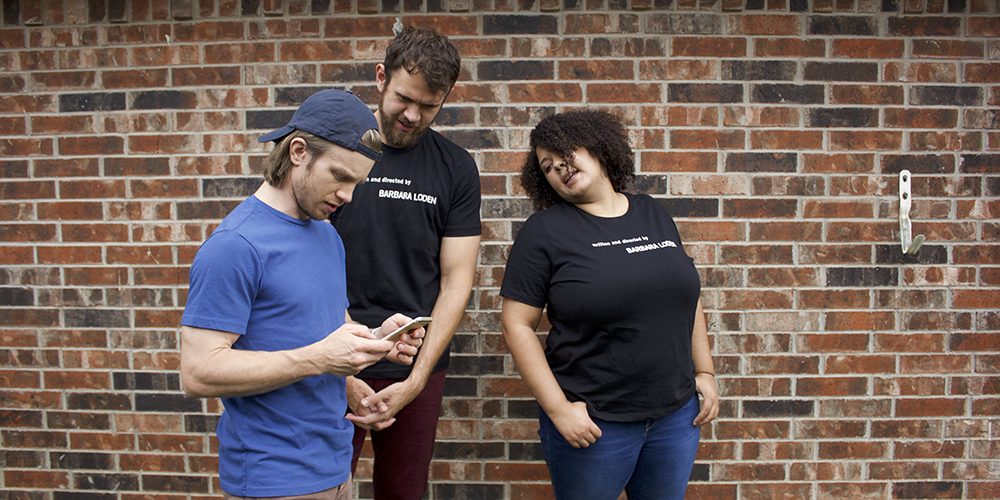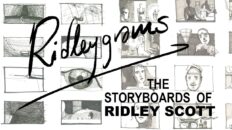RUD: Colin, thank you for sitting down with us and answering a few questions. You’ve launched this site, teesenscene.com, and you’re making t-shirts that appeal to a very niche audience. What inspired you to embark on this endeavor?
Stacy: It all started when I met Steven Soderbergh in Plano, TX. He’d just finished filming Logan Lucky and was screening a rough cut of the film for a test audience at a local Cinemark. I noticed that he was in the crowd a few rows down from me so I set my heart on hunting him down when the lights came up. Once the credits and crowd dissipated, I found him at the bar. We shook hands and talked about the production and parted ways. His shirt stuck out to me: a black tee that read “A Film by Mike Nichols.” I took to Facebook to brag about the encounter and mentioned his shirt and that I should make one for Elaine May. Nichols and May were a massively popular comedy duo in the 50s and 60s. And the people–cinephiles mainly–responded. From there I began a Kickstarter campaign to fund the shirts, which had changed from “A Film by Elaine May” to “Written and Directed by Elaine May” from her film Mikey and Nicky. The campaign was wildly successful, raising over 250% of the original goal. After the Kickstarter I was able to produce another couple hundred shirts and start a webstore.
The success of the shirt company has been a fun ride, but tees-en-scène isn’t just about film apparel. Elaine May was for decades an outcast in an industry that favors and funds the capital and work of powerful men. The production model has always been biased toward male filmmakers and stories. But we’re in a time of change. It’s a watershed moment for Hollywood and the industry proper, and I think Elaine May is a shining example of Hollywood’s ills toward women filmmakers. She is not only a comedy genius but one of the most original filmmakers to come out of the 70s–the “New Hollywood” period–which so many hold up as the golden age of American filmmaking. Yet, until now, she’s rarely been mentioned as an equal with Scorsese or Coppola or, hell, even Nichols. After Ishtar bombed at the box office, she left the director’s chair. The table hadn’t been set for a voice and vision like hers: the female auteur was shunned. But the tide is turning and, I believe, she has become an artist for our generation. Her work has been featured in numerous retrospectives across the globe over the last few years. The shirt everyone made together is an act of love and respect. I think it’s about wanting to celebrate and elevate the voices, notably those of women and people of color, that have long been pushed to the margins. From the Kickstarter to the official tees-en-scène store, that’s what I want this project to be about.
RUD: Your first two designs, “Written and directed by Elaine May” and “Written and directed by Barbara Loden” are referencing two actresses who also ventured into directing. But they’re both very much outside the mainstream. Can you tell us a little about them and why you chose to feature them?
Stacy: Both are outside of the mainstream but should have been as major as their male peers. With an oeuvre that features A New Leaf, The Heartbreak Kid, Mikey and Nicky, and Ishtar, May was always interested in dissecting then obliterating the male psyche. Her films understand the American male more than any other filmmaker of that time and continue to resound today. They’re tragicomic masterpieces that should be forever in conversation with the greats of the 20th century. A shirt is just a shirt but it’s something that begin conversations, that allows people to share their love of her work.
Barbara Loden is another major filmmaker from the 70s whose only feature-length film, Wanda, plays like a transmission from another dimension. It’s a feminist study of a woman wandering through the dire crags of Appalachian coal country. As a look into the interiority of a poor, working class woman without the inherent gains of patriarchal mobility, she rambles through this world like an alien seeking to make her way. Each encounter is like further programming for Wanda as she navigates the most restrictive of social paths. There’s an abusive relationship and a bank heist gone awry, but they are things that just further alienate her. Despite its distancing effect, it possesses an immensely felt interiority. It’s obvious many mainstream critics in the early 70s–mostly male, of course–didn’t know how to to write about the film or Loden or Wanda as a character. It’s by design a work of elusion and disassociation, as if it weren’t meant to be understand in that time. Barbara died in her 40s from breast cancer. She made two other short films and had a multitude of projects she wanted to see through. But again, her career was victim to a patriarchal industry.
But even May and Loden had certain privileges as white women in the industry. They got to make films, ones that were even seen by mainstream audiences. BIPOC (Black, Indigenous and People of Color) women still struggle to have their films funded and seen. There’s still a lot of work to be done.
RUD: You spoke about Loden’s sole directorial effort, Wanda, and it is being re-released in select theaters this summer. Why is that important?
Stacy: For one, it’s been essentially unavailable to wider audiences for years. Other than a now out-of-print DVD release that’ll run you well over $70, you can only see the film when it pops up on YouTube or if you live near an area that’s screened it on a print or, well, have alternate means of obtaining a copy. Also, as an American woman’s story, especially one with such a keen vision of class and poverty, I think it’s a defining work of cinema. It shows what a filmmaker can do with a small budget when you have the formal and writing clarity that Loden possessed. It’s a story about the margins, made from the margins, and it sees its world in an honest, incisive way that this generation is hungry for.
RUD: tees-en-scène is witty play on “mise-en-scène,” the arrangement of the scenery we see in the background of stage plays or films. Does the name have any deeper meaning to you than just being a witty pun?
Stacy: I don’t want to make it more than it is; it’s definitely just a witty pun! Though I do think over time it could maybe take on some deeper meaning. It conveys a sense of responsibility about what we wear, about what these shirts can say about the scene of the filmmaking industry today. Ultimately that who should make up and anchor the industry should be rearranged. We need new frames, different sets; the old things should pass.
But, really, it’s just a fun name.
RUD: The profits from the sales of your t-shirt are going to support clèo, a film journal who brands itself as “A Journal of Film and Feminism,” and filmmaking projects from women of color. Why?
Stacy: I gave a portion of the Kickstarter profits to clèo. You know, it’s feminist, woman-led criticism that has shouldered much of the burden of elevating and celebrating voices that have been historically marginalized, and it’s these critics and their projects that led me to have a deeper awareness of those filmmakers. I’d be lost without them. I feel it’s my responsibility to give back and help fund the work they’ve been doing. It’s about being a good ally, to be relied on to step up and speak out, especially as a white man, for those voices my kind has oppressed. It’d be absolutely exploitative for me to make and sell shirts with women’s names on them and hold those profits for myself. It’d be propping up the very patriarchal structures that the project of elevating these voices is trying to dismantle. I don’t want to be complicit in that, so I’m giving it back to those who deserve it. Another thing I do is ask a female critic to write a short piece on what that filmmaker has meant to them and I print that and send it along with every shirt. It’s another small way I can elevate women and their work. And now that tees-en-scène is picking up steam I want to set bigger goals for the project, so I plan to give a percentage of the ongoing profits to help fund a filmmaking project(s) from a woman of color. The industry has marginalized these voices most so I want tees-en-scène to be a project of decolonization, to take what little impact a personal project like a t-shirt company can have and give it to people who don’t have the privileges I’ve had all my life.
RUD: What do you hope to do next? Are there any shirts you’d like to create? Female directors you’d like to highlight?
Stacy: There are so many new shirt designs I have in mind! Next up, I think, is Kathleen Collins. She was a black filmmaker, writer, playwright, and activist who directed two films in the 80s, The Cruz Brothers and Miss Malloy and Losing Ground. The latter is one of the first feature-length films directed by a black woman. It’s a staggering work of feminist filmmaking, that even after a home video release and a streaming stint on FilmStruck, is still not as widely seen as it deserves.
There’s a slew of other female directors I want to highlight, notably queer and transgender artists like Cheryl Dunye, Angela Robinson, Chantal Akerman, and the Wachowski sisters. That shirt, or collection, will probably be a collaboration with a critic friend of mine, Juan Barquin, who runs an ongoing project in Miami called Flaming Classics that highlights queer film and culture in really beautiful ways. What he’s doing down there is essential. I also want to make shirts in honor of more popular filmmakers like Amy Heckerling, Nancy Meyers and Nora Eprhon. There’re plenty of female filmmakers to highlight and celebrate. Now, everyone, go watch their films!








